How to Harvest Sunflower Seeds
- March 29, 2024
- 0 comment
Discover How to Harvest Sunflower Seeds from your garden’s radiant sunflowers. This guide walks you through the simple yet rewarding process of collecting nutritious and tasty seeds, ensuring you fully enjoy the benefits of these beautiful blooms.
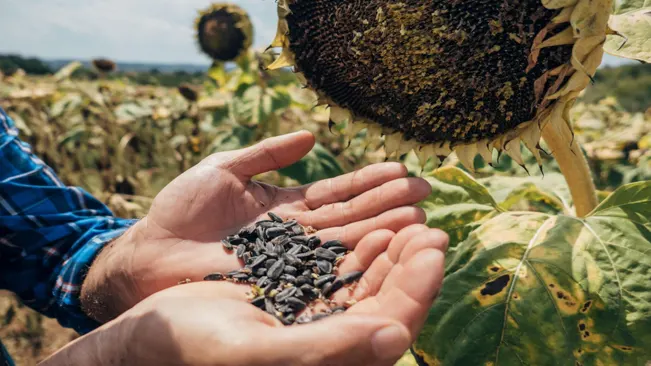
| Benefit | Description |
|---|---|
| Rich in Nutrients | Sunflower seeds are packed with vitamins and minerals including Vitamin E, B1, B6, magnesium, phosphorus, and selenium. |
| High in Antioxidants | The seeds contain antioxidants like Vitamin E and selenium which help fight oxidative stress and inflammation. |
| Supports Heart Health | They have high levels of unsaturated fats, which can be beneficial for heart health and help reduce cholesterol levels. |
| Helps in Blood Sugar Control | Consuming sunflower seeds may aid in controlling blood sugar levels, making them beneficial for people with diabetes. |
| Promotes Healthy Skin | Vitamin E in sunflower seeds helps in maintaining healthy skin by protecting against sun damage and aging. |
| Boosts Energy Levels | Being rich in B vitamins, which are essential for energy production, sunflower seeds can be an energizing snack. |
| Supports Digestive Health | High in dietary fiber, sunflower seeds can help promote regular bowel movements and support overall digestive health. |
| May Reduce Inflammation | Nutrients like Vitamin E and flavonoids in sunflower seeds may help in reducing inflammation in the body. |
| Supports Immune Function | The selenium and zinc in sunflower seeds are known for their role in boosting immune system function. |
| Mood Enhancer | Magnesium in sunflower seeds can help in combating stress and anxiety, promoting a sense of well-being. |
Understanding the Right Time for Harvest
- Why Timing Matters: Harvesting sunflower seeds too early or too late can affect their quality. Early harvesting can result in underdeveloped seeds that lack flavor and nutritional value. On the other hand, harvesting too late can lead to seed loss, as birds and squirrels are attracted to the seeds, and overripe seeds may fall off the head or become moldy.
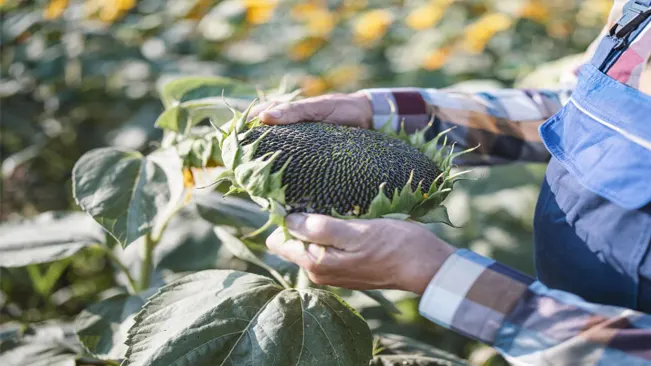
Observing the Sunflower’s Lifecycle
- Lifecycle Stages: Sunflowers go through distinct stages. After the blooming period, the flowers start to fade, indicating the beginning of the seed maturation process. The back of the sunflower head will change from green to yellow and eventually to a brown color. This transition is a clear indication that the seeds are nearing maturity.
Physical Changes in the Sunflower Head
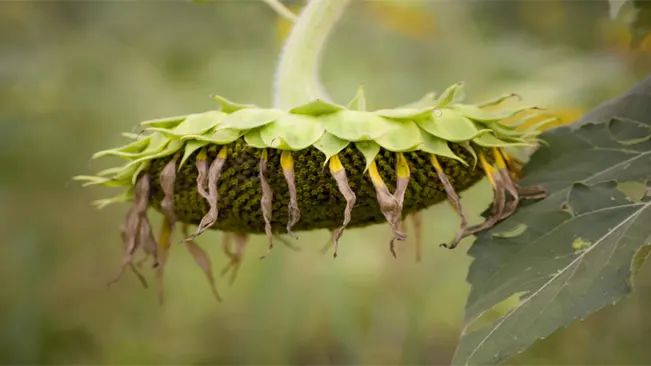
- Appearance of the Head: The head of the sunflower will start to droop, signaling that the seeds are getting heavier and the stem is beginning to dry. The flower petals, once bright and yellow, will wilt and fall off, exposing the seeds.
Checking the Seeds
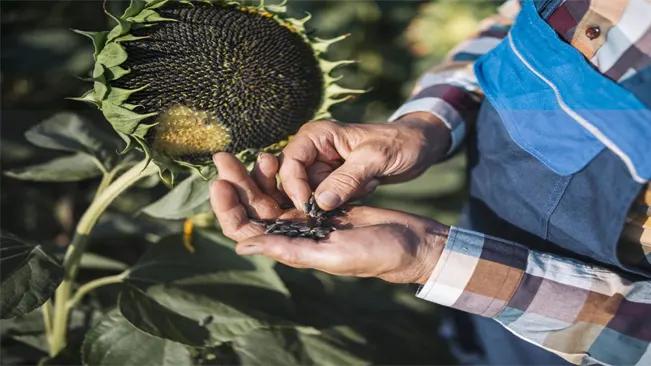
- How to Check: Carefully peel away a portion of the seed head to reveal the seeds. It’s advisable to check seeds from different parts of the head, as they may not all mature at the same rate.
- Seed Appearance: Mature seeds are usually plump, and their shells have a firm texture. The color of mature seeds is typically striped in shades of black, gray, and white, although this can vary with different sunflower varieties.
- Testing Seed Readiness: Gently squeeze a seed. If it feels firm and the shell is hard, it’s a good indication that the seed is ready. You can also taste a seed; if it has a nutty flavor and the inside is meaty, it’s time to harvest.
Environmental Factors
- Climate Impact: The timing of harvest can be influenced by your local climate. In areas with wet, humid conditions, it might be necessary to harvest a bit earlier to prevent mold and rot.
- Observation is Key: Regularly checking your sunflowers as they mature is crucial. Look for the tell-tale signs of maturity – brown back, drooping head, loss of petals, and the appearance of the seeds themselves.
Preparing for Harvest
Materials Needed: Sharp Scissors or Pruning Shears
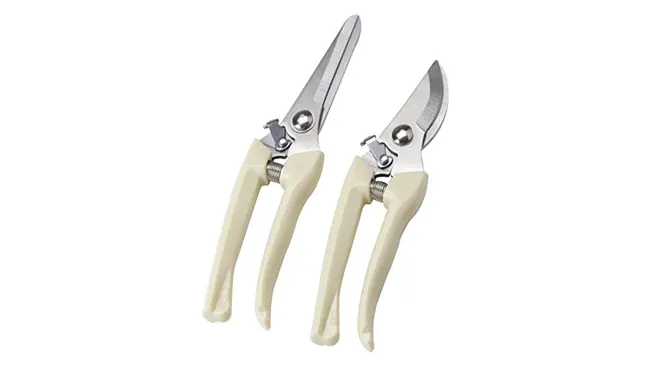
- These are essential for cutting the sunflower heads from the plant. Ensure they’re sharp for a clean cut, which is better for the plant in case you leave the stem for regrowth or for aesthetic purposes in your garden.
Container or Bag
- This will be used to collect the seeds as you remove them from the flower head. Choose a size based on how many sunflowers you’re harvesting. A bucket or large bowl works well for larger harvests, while a bag or small container may suffice for just a few heads.
Gloves (Optional)
- Sunflower heads can be prickly, and the stems may be tough and scratchy. Wearing gloves can protect your hands from getting pricked by the sunflower’s rough textures. Additionally, if you’re allergic to pollen or have sensitive skin, gloves can provide an extra layer of protection.
Additional Considerations
- Clothing: You might want to wear a long-sleeved shirt and pants to protect your skin from the sunflower’s rough leaves and stalks, especially if you’re working on a sunny day or have sensitive skin.
- Timing: Plan to harvest on a dry day. Moisture from rain or dew can make the seeds soggy and complicate the drying process.
- Transportation: If your sunflowers are located far from where you intend to process them, consider how you’ll transport the heads without losing seeds. A wheelbarrow, garden cart, or even a tarp can help.
- Clean Workspace: Prepare a clean, flat surface for processing the sunflower heads after harvest. This could be a table, a wide bench, or any flat area where you can comfortably remove and sort the seeds.
- Labeling Materials (if needed): If you’re harvesting different varieties of sunflowers and want to keep their seeds separate, have labels and markers ready to identify each variety.
The Harvesting Process
Cutting the Head
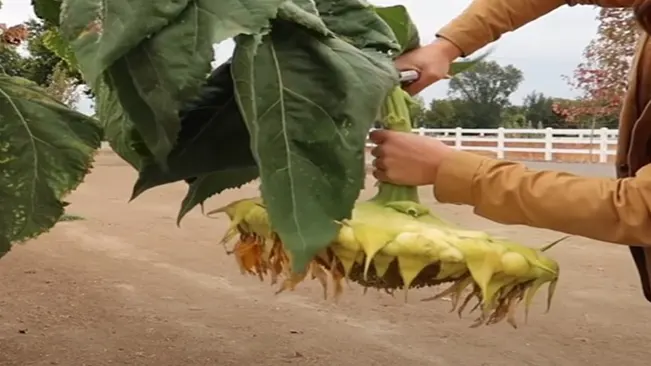
- Choosing the Right Time: It’s important to cut the head of the sunflower when it’s just right – not too early nor too late. The back of the sunflower head should be brown, and most of the petals should have fallen off. This indicates the seeds are mature enough for harvesting.
- Using the Right Tools: A sharp pair of garden scissors or pruning shears is essential to ensure a clean cut. Dull tools can crush the stem and damage the head, potentially harming the seeds.
- Preserving the Stem: Leaving about six inches of stem makes it easier to handle the head without touching the seeds. It also allows you to hang the head for drying if you choose that method.
Removing the Seeds
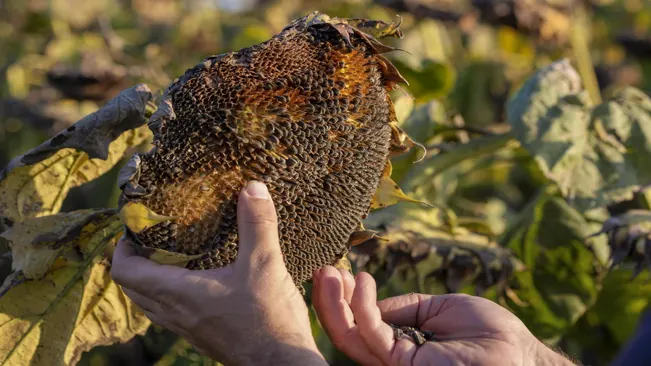
- Rubbing Method: This is the quicker of the two methods. Holding the head over a container, you rub or brush the seeds gently with your hand or a piece of cloth. The seeds should fall out if they are ripe enough. This method works well for larger heads with looser seeds.
- Hand-Picking Method: If the seeds don’t easily dislodge, or if you prefer a more deliberate approach, picking the seeds by hand is the way to go. This method is slower but gives you more control, and it’s less likely to damage the seeds. It can also be a relaxing, almost therapeutic activity. Simply grasp each seed and twist it gently to detach it from the head.
- Advantages of Hand-Picking: Apart from being a mindful activity, hand-picking allows you to inspect each seed as you go. This way, you can discard any seeds that are damaged or not fully mature.
Drying the Seeds
Why Dry Sunflower Seeds?
- Prevent Mold and Spoilage: Moisture can cause the seeds to mold or spoil. Drying removes moisture, extending their shelf life.
- Enhance Flavor: Drying can also improve the flavor, especially if you plan to roast the seeds later.
- Prepare for Storage: Properly dried seeds can be stored for a long time without losing quality.

How to Properly Dry Sunflower Seeds
- Spread the Seeds Evenly
- Lay the seeds out in a single layer on a flat surface. A mesh screen, a clean window screen, or a paper-covered tray can be used. This ensures each seed gets adequate air exposure.
- Choose the Right Location
- Place the seeds in a warm, dry place. Avoid direct sunlight as it can overheat the seeds, potentially spoiling the natural oils. A well-ventilated room or a shaded, airy outdoor area is ideal.
- Stirring for Even Drying
- Occasionally stir or shuffle the seeds. This practice ensures that all sides of the seeds dry evenly, preventing any moisture pockets that could lead to mold.
- Monitoring Moisture Content
- Check the seeds periodically. They should feel dry to the touch and the shells should crack open easily when they’re fully dried.
- Duration of Drying
- The drying process generally takes a few days, but this can vary depending on the humidity and temperature of the drying area.
- Testing for Dryness
- To test if the seeds are completely dry, try cracking a few open. If the inside is firm and the shell cracks crisply, they are likely dry enough.
Post-Drying Considerations
- Cooling Down: Let the seeds cool down to room temperature before storing or roasting.
- Roasting (Optional): If you plan to roast them for eating, the drying process is a perfect precursor. Roasting can further enhance the flavor and crunchiness.
- Storing: Once cooled, store the seeds in an airtight container in a cool, dark place like your pantry.
Storing the Seeds
Ensuring Drying Completeness
- Importance of Complete Drying: The presence of moisture in sunflower seeds can lead to mold growth and spoilage. This is especially critical if you’re planning to store the seeds for an extended period.
- Testing for Dryness: To ensure that the seeds are completely dry, take a few and try breaking them. The shell should crack easily, and the seed inside should be firm and not bendable. If they feel soft or rubbery, they need more drying time.
- Method of Drying: After harvesting, the seeds should be laid out in a single layer in a warm, well-ventilated area, away from direct sunlight. Stirring or turning them occasionally ensures even drying.
Choosing the Right Storage Containers
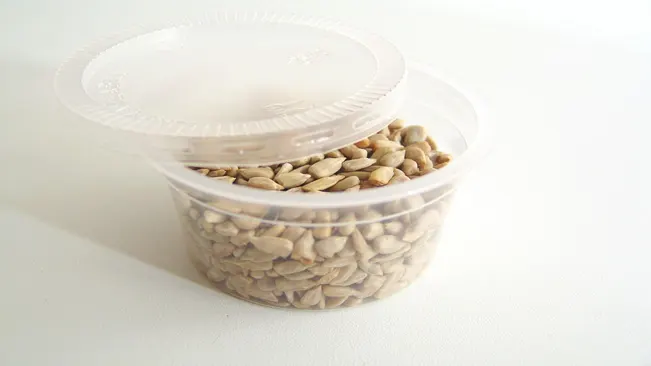
- Types of Containers: Airtight containers are essential to prevent moisture and air from getting in. Glass jars with tight-fitting lids, metal tins with secure closures, or even high-quality ziplock bags are suitable options.
- Avoiding Plastic Containers: While plastic can be used, it’s not always the best choice as it can sometimes allow air and moisture to penetrate. Glass and metal are generally more reliable for long-term storage.
- Labeling: It’s a good practice to label your containers with the date of harvest. This helps in tracking the age of the seeds and using older stocks first.
Finding the Ideal Storage Location
- Temperature and Humidity: Sunflower seeds should be stored in a cool, dry place. High temperatures can cause the oils in the seeds to go rancid, while high humidity can lead to mold growth.
- Ideal Locations: A pantry, cupboard, or any other area in your home that stays cool and doesn’t experience large temperature swings is ideal. Avoid storing near ovens, stoves, or areas that receive direct sunlight.
- Long-Term Storage: For long-term storage, you can consider the refrigerator or freezer. This can extend their shelf life, but ensure they are in airtight containers to prevent moisture buildup and odor absorption.
Enjoying Your Harvest
Your harvested sunflower seeds can be enjoyed in various ways. Eat them raw, roast them for a crunchy snack, or incorporate them into recipes for an extra boost of nutrition and flavor. They are rich in healthy fats, protein, fiber, and minerals like magnesium and selenium.
Eating Them Raw
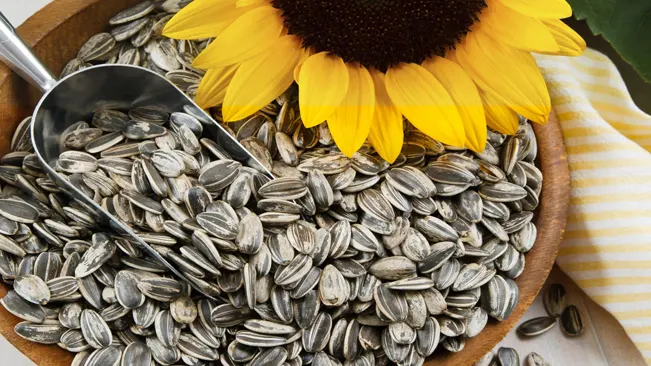
- Natural Goodness: Consuming sunflower seeds in their raw form ensures you get all the natural nutrients without any added ingredients. They make for a great, healthy snack straight from your garden.
- Preparation Tips: It’s advisable to rinse and dry them first. You can shell them or eat them with the shell, though most people prefer to remove the shell.
Roasting Sunflower Seeds
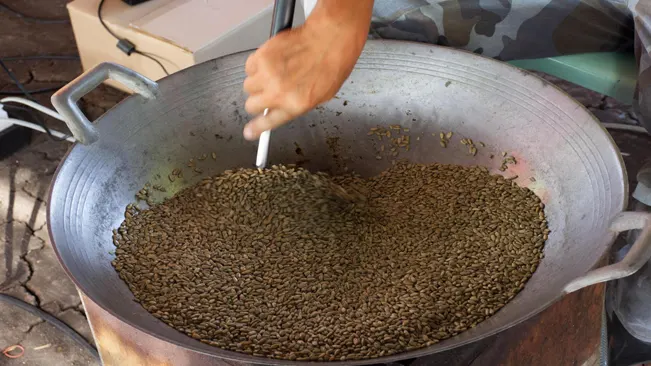
- Flavor Enhancement: Roasting sunflower seeds brings out a nuttier, more pronounced flavor and adds a delightful crunch.
- Simple Roasting Method: To roast, spread the seeds in a single layer on a baking sheet. You can roast them plain or toss them with a bit of oil and your choice of seasonings (salt, garlic powder, paprika, etc.). Bake in a preheated oven (about 300°F or 150°C) for 30 to 40 minutes or until they are golden brown, stirring occasionally.
Adding to Recipes
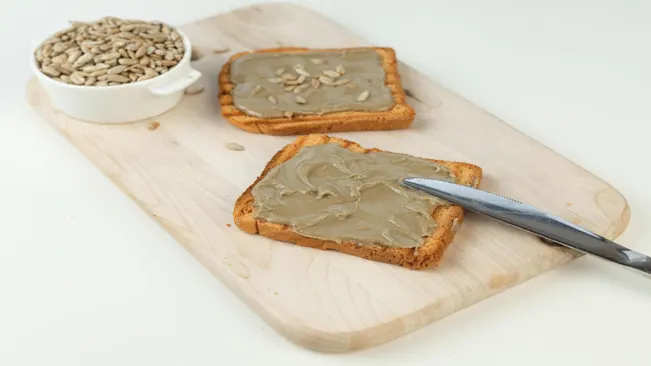
- Versatile Ingredient: Sunflower seeds can be a fantastic addition to various dishes. Sprinkle them over salads for a crunchy texture, blend them into smoothies for a nutty flavor, or incorporate them into baked goods like bread and muffins for added nutrition.
- Butter Alternative: You can also make sunflower seed butter, a great alternative to peanut butter, especially for those with nut allergies.
Health and Nutrition
- Nutrient-Rich: Sunflower seeds are not just tasty; they’re also packed with essential nutrients. They are an excellent source of Vitamin E, a powerful antioxidant, and are rich in B vitamins, particularly thiamin and niacin.
- Healthy Fats: They contain beneficial polyunsaturated and monounsaturated fats, which are important for heart health and maintaining healthy cholesterol levels.
- Protein and Fiber: These seeds are a good source of plant-based protein, making them a great snack for vegetarians and vegans. They also provide dietary fiber, aiding in digestion and promoting a feeling of fullness.
Conclusion
Harvesting sunflower seeds is a straightforward process that brings you closer to nature and provides you with a healthy, home-grown treat. It’s a delightful way to end the growing season and enjoy the fruits of your labor. So next time your sunflowers are in bloom, remember this guide and look forward to harvesting your very own sunflower seeds.
FAQs (Frequently Asked Questions)
- When is the right time to harvest sunflower seeds?
- Harvest when the backs of the flower heads turn brown and the petals have fallen off.
- Harvest when the backs of the flower heads turn brown and the petals have fallen off.
- How do I know if the sunflower seeds are ready to harvest?
- The seeds are ready when they are plump, and the shells have a hard, striped pattern.
- The seeds are ready when they are plump, and the shells have a hard, striped pattern.
- What tools do I need for harvesting sunflower seeds?
- You’ll need a sharp pair of scissors or pruning shears, a container to catch the seeds, and optional gloves.
- You’ll need a sharp pair of scissors or pruning shears, a container to catch the seeds, and optional gloves.
- How do I remove the seeds from the flower head?
- You can either rub the seed head over a container to dislodge the seeds or pluck them out by hand.
- You can either rub the seed head over a container to dislodge the seeds or pluck them out by hand.
- Do I need to dry the sunflower seeds after harvesting?
- Yes, drying is important. Spread them out in a single layer and let them dry for several days.
- Yes, drying is important. Spread them out in a single layer and let them dry for several days.
- How can I tell when the sunflower seeds are completely dry?
- The seeds should be hard and not bendable, and the shells should crack easily.
- The seeds should be hard and not bendable, and the shells should crack easily.
- What is the best way to store harvested sunflower seeds?
- Store them in an airtight container in a cool, dry place, such as a pantry or cupboard.
- Store them in an airtight container in a cool, dry place, such as a pantry or cupboard.
- Can I harvest seeds from any type of sunflower?
- Yes, but some varieties are better for seed harvesting, like the large-headed varieties.
- Yes, but some varieties are better for seed harvesting, like the large-headed varieties.
- Is it necessary to protect the sunflower heads from birds and squirrels?
- Yes, it can be helpful to cover the heads with mesh or a paper bag as they begin to mature.
- Yes, it can be helpful to cover the heads with mesh or a paper bag as they begin to mature.
- Can I eat the seeds directly after harvesting them?
- While you can eat them raw, many prefer to roast them for enhanced flavor and texture.

Kristine Moore
Forestry AuthorI'm Kristine Moore, a seasoned garden landscaping professional with over 30 years of experience. My extensive career has been dedicated to transforming outdoor spaces into stunning, sustainable landscapes. With a deep understanding of horticulture, design principles, and environmental stewardship, I have become a respected figure in the field, known for creating harmonious, visually appealing, and eco-friendly gardens. My commitment to excellence and continuous learning in landscaping trends and techniques has solidified my reputation as an expert in garden design and implementation.


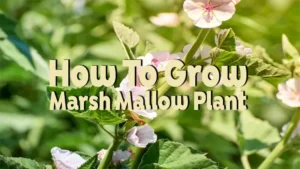
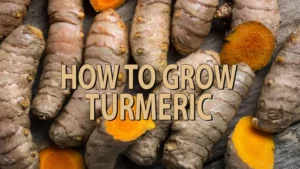


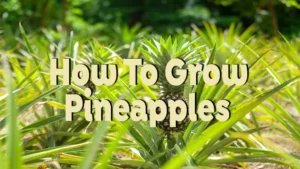

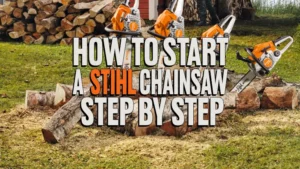


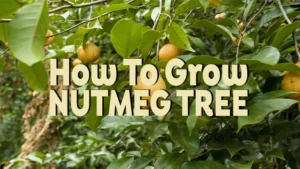
Leave your comment